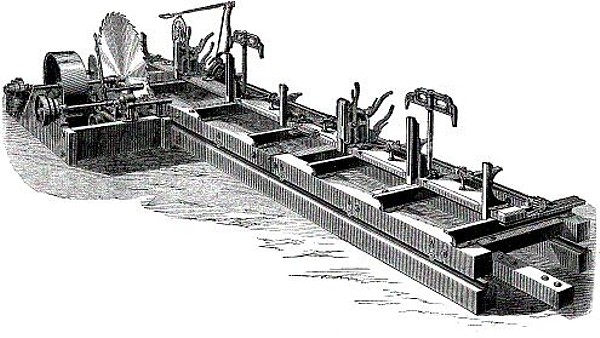|
Title: |
1884 Article - Chase's Improved Saw Mills |
|
Source: |
Manufacturer and builder / Volume 16, Issue 5, May 1884, p. 101 |
|
Insert Date: |
12/17/2012 8:28:31 PM |
Article text:
CHASE'S IMPROVED SAW MILLS
The illustration given herewith represents one of the numerous forms of stnndard circular-saw mills manufactured by the Chase Turbine Manufacturing Co., of Orange, Mass. These makers manufacture single and double mills, with two styles of carriage - that is, with rolls in the carriage or on the floor. The mill shown herewith is a single mill, with rolls in the carriage, iron tracks planed true, laid on timbers on the floor, the rolls running in heavy, whole-plate, self-oiling boxes set in the carriage. In the other style of carriage, the rolls are set in iron chairs on the floor, this disposition being shown in the small cut in the upper right-hand corner of our engraving.
The several sizes of these mills are designated by numbers from 1 to 3. No. 1 has a carriage from 12 to 24 feet in length, 3 feet 4 inches in outside width, and adapted for saws from 36 to 52 inches diameter. No. 2 has a carriage from 12 to 48 feet long, 3 feet 8 inches wide, with saw from 42 to 60 inches diameter. No. 3 has a carriage from 12 to 48 feet long, 4 feet wide, with saw from 54 to to 78 inches diameter. Double mills of the same sizes.
Each of these sizes is made with iron saw frames when required. The set works are adapted to any size of old mills, and are always the same length of carriage, except when ordered otherwise, being furnished separate, and of any required length. The makers put three feet additional length of feed-rack at each end of the carriage, so that every mill will feed and saw at least five feet longer than the length of carriage given in their printed tables of dimensions. They also furnish right or left hand as may be desired.
In the construction of their mills, the makers lay stress on the fact that they use the best selected and seasoned stock throughout. The saw boxes are held together by joint bolts, and the carriages by long rods running through from side to side. The arbors are of steel, running in heavy, self-adjusting pivot boxes; the pulleys are iron, and carefully balanced. The feed or gig works are of improved design, being wood and iron friction pulleys running together, and giving a feed which is always under perfect control.
Of other features, the following important improved attachments are worth noticing: The ?double drop dogs," which are of cast steel, and which it is claimed will hold any log, whether frozen or not, until it is completely sawed. They are instantaneous in operation, and the makers consider them the best in use. The double-lift dog, by which a round log is securely held underneath to prevent slipping when frozen, and to hold a crooked log when it will not rest on the head-block. The arrangement for running back the set-beam by pulling forward on the lever, which the makers claim to be the quickest and easiest arrangement thus far devised. Their new dial index or circular rule, which shows at a glance the exact distance from the saw to the uprights on the carriage, the numher of boards there are in a log of all the different thicknesses, or how large a slab should be taken off after the log is turned over, so as to have the last board come out the correct thickness, effecting a great saving of time and of many vexatious mistakes. And lastly, the new power foot rig of the manufacturers for in moving the set-beam backward or forward.
The foregoing will enable our readers specially interested in this class of machinery, to judge of the completeness with which these makers have endeavored to provide their mills with every appliance for effecting economy of time and labor, while, at the same time, maintaining the highest degree of efficiency. Their mills have been so well tried and approved that they have come to be regarded as standard of this class.
We refer for many details necessarily omitted here, to the makers, or to their New York agents, Edw. P. Hampson & Co., 36 Cortlandt street. |
|
 1884 Chase's Improved Saw Mills
1884 Chase's Improved Saw Mills
|
|